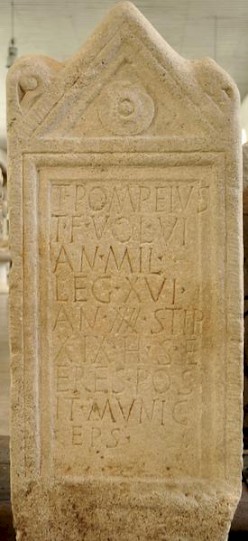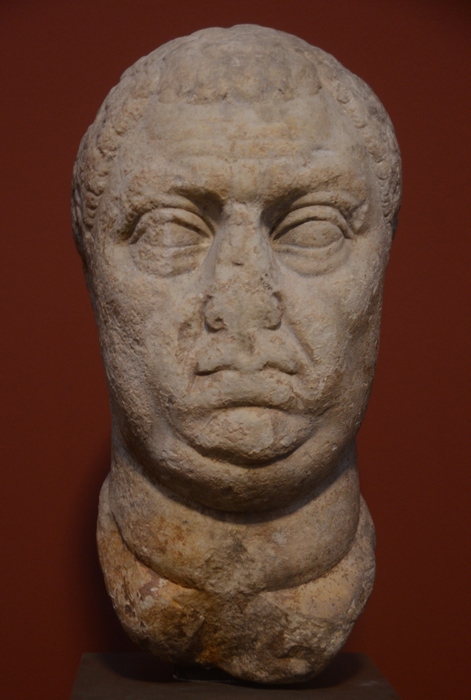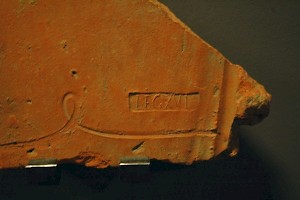Legio XVI Gallica
Legio XVI Gallica: one of the Roman legions. Its name means "the legion from Gaul".

This legion was founded in 41 or 40 by Julius Caesar's heir Octavian, who needed it to put an end to Sextus Pompeius' occupation of Sicily, which put the grain supply of Rome into peril. When Pompeius was defeated (36), the unit was perhaps sent to Africa, where several coins have been found with the legend LEG XVI and a portrait of a very youthful Octavian.
The relations between Octavian and his fellow-triumvir Mark Antony deteriorated and they started a war, which culminated in the naval battle off Actium (31), where Octavian defeated his opponent and won the supremacy in the Mediterranean world. From now on, he was known as the emperor Augustus.
XVI Gallica was now sent to the Rhine, together with three other legions that have been founded at the same time: XVII, XVIII and XIX. The Sixteenth was based in what was to become known as Germania Superior. Its base was probably at Mainz, although evidence for the period BCE is lacking. Raetia cannot be excluded.
In 6 CE, Augustus' son-in-law Tiberius was to lead at least eight legions (VIII Augusta from Pannonia, XV Apollinaris and XX Valeria Victrix from Illyricum, XXI Rapax from Raetia, XIII Gemina, XIV Gemina and XVI Gallica from Germania Superior and an unknown unit) against king Maroboduus of the Marcomanni in Czechia. At the same time, I Germanica, V Alaudae, XVII, XVIII and XIX were to move against Czechia as well, attacking it along the Elbe. It was to be the most grandiose operation that was ever conducted by a Roman army, but a rebellion in Pannonia obstructed its execution.

In the autumn of 9 CE, when XVII, XVIII and XIX had been destroyed in the Teutoburg Forest, the Sixteenth briefly occupied towns like Cologne and prevented a Germanic attack on Gallia Belgica. However, the legion's base remained Mainz, where it was in the year of the death of Augustus, 14, together with the Fourteenth.
In the winter of 40/41, Servius Sulpicius Galba (the future emperor) overcame the Chatti, who lived near Mainz, and although XVI Gallica is not mentioned in Cassius Dio's brief description of the war, it must have taken part in the struggle.note
In 43, when the emperor Claudius took away XX Valeria Victrix from Neuss to invade Britain, XVI was transferred to Neuss in Germania Inferior. The legionaries seem to have rebuilt part of their new fortress, probably using stones they had quarried in the valley of the Brohl.
In 67, the position of the emperor Nero became untenable: many senators were discontent and several governors discussed his removal. Among these were Lucius Clodius Macer of Africa (who recruited the I Macriana Liberatrix) and Gaius Julius Vindex of one of the provinces in Gaul. They supported the governor of Hispania Tarraconensis, Servius Sulpicius Galba, when he proclaimed that he wanted to dethrone Nero.

This was treason, and the legions of Germania Inferior (I Germanica, V Alaudae, XV Primigenia and XVI Gallica) knew what they had to do. They marched to the south and defeated Gaius Julius Vindex. The soldiers expected to be rewarded, but they were disappointed: Galba and a newly recruited Seventh legion marched on Rome, the Senate recognized him, and Nero committed suicide (June 68). What had been exemplary behavior, was now explained as an attempt to obstruct the accession of the new emperor, who did not really hide his contempt for the Rhine army.
Therefore, the army of Germania Inferior acclaimed their own commander, Vitellius, as emperor, and marched on Rome (January 69). They were successful, and Vitellius started his reign. However, in Judaea, general Vespasian, who was waging war against the Jews, had also decided to make a bid for power; the two armies clashed near Cremona in northern Italy, and the Rhine army turned out to be no match for the soldiers of Vespasian.
Meanwhile, in Germania Inferior, a disaster was in the making. The Batavians felt offended because Galba had dismissed his Batavian bodyguard, and revolted. A Roman expeditionary force, consisting of the remains of V Alaudae and XV Primigenia, was defeated near Nijmegen, and in the winter of 69/70, these two units found themselves besieged at Xanten. Although I Germanica, XVI Gallica and a legion from Germania Superior, XXII Primigenia - first commanded by Hordeonius Flaccus, later by Dillius Vocula - tried to rescue them, the two legions at Xanten were forced to surrender in March 70, and massacred. Not much later, I Germanica and XVI Gallica surrendered as well, at Bonn.

It took several months before the new emperor Vespasian could send a strong Roman army to recover the Rhineland, commanded by his relative Quintus Petillius Cerialis. The legions V Alaudae and XV Primigenia were never reconstituted; XVI Gallica and IIII Macedonica, which had guarded Mainz, were renamed (XVI Flavia Firma and IIII Flavia Felix); the remains of I Germanica were added with Galba's Seventh legion and became known as VII Gemina ("the twin legion").
Its legionary symbol probably was a lion.